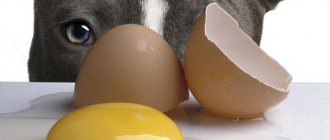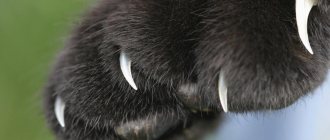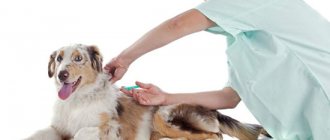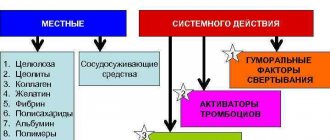Can dogs have their whiskers trimmed? This question is sometimes asked by pet owners. Some will answer with a clear “no,” but they will not be able to motivate such an answer. Why do dogs need whiskers at all, how are they used and can they be cut, why do dogs lose their whiskers - all this is discussed in detail in the article.
Many questions are asked about dog whiskers.
Where do whiskers grow?
Vibrissae in dogs grow exclusively on the animal's face. Vibrissae are the same whiskers, this is just their scientific name. The singular form will be called vibrissa.
Antennae grow on the cheeks, above the eyebrow, on the chin, near the lips. Some are clearly visible, others are too short and are not visible against the background of the general fur.
Their main difference from wool is the denser structure of the hair. In addition, the color of the whiskers is much darker, so they can be easily distinguished on light fur. However, if the dog's hair is dark and long, the whiskers may not be noticed and can be cut off. Therefore, experts recommend contacting haircutting professionals.
Important! In short-haired dogs, such as Chihuahuas, Jack Russells, and pugs, the whiskers are much more visible.
While they are almost impossible to find in Spitz, York, and Maltese dogs.
Keep your mustache healthy and don’t let it grow
Trim your mustache every 1-2 weeks
How often you need to trim your mustache depends on how quickly it grows. For most men, this is about twice a month. If you have thick and unruly hair, it is better to cut it weekly.
If you make trimming your mustache a habit and choose a length and style that complements your face, the process will become as natural as brushing your teeth.
Check to see if you have any stray hairs or particularly thick areas, even if you have already grown a long mustache.
Use shampoo and conditioner
It's only natural to take care of your mustache with the same care you take for the hair on your head. If you want the hair above your lip to be silky and smooth, buy cleansing and moisturizing products. For convenience, you can purchase shampoo and conditioner in one bottle. Spend a couple of extra minutes in the bathroom and you will be pleasantly surprised.
You don't have to wash your mustache as often as your head. In most cases, 3-5 times a week is enough.
Buy an exfoliating facial scrub
It unclogs pores and removes dry dead skin cells. Your face will become healthier - both in appearance and in feel.
This is especially important if the vegetation is dark: due to the difference in colors, flaky skin becomes more noticeable
Get into the habit of using a scrub after every morning shower or just before you go to bed.
Use a little wax for easy styling
Take just a little bit of wax and apply it to your mustache from root to tip to create the desired shape. Such products do not dry out, so your facial hair will look neat all day long.
You don't need to apply a lot of wax to your mustache, otherwise it will become greasy and unkempt.
Why are vibrissae needed?
Why do dogs need whiskers? To answer this question, you need to understand a little about their structure. First of all, vibrissae are very sensitive hairs with a large number of nerve endings. In contact with surrounding objects, the whiskers send a signal to the animal’s brain and provide information that helps to move. In other words, dogs need vibrissae in order to better navigate in space. In addition, the mustache improves tactile perception and helps the dog in finding food or identifying other animals.
It should be understood that there is no need to trim dogs' whiskers, since this leads to a kind of inferiority of the animal. The pet will be less able to navigate the area.
Important! The same applies to cats, but for them the whiskers are an even more important element than for dogs. If cats' whiskers are cut off, they become completely lost in space.
Helps to navigate in space
What is grooming
Grooming is part of grooming, the concept of which first appeared in the care of French poodles in the 19th century. It was then that unique haircuts for this breed appeared, for example, “Lion” or “Continental”. For the most part, these dogs were used for duck hunting, and this type of coat helped protect the dogs from hypothermia and improved their swimmer qualities. Peculiar poodle grooming salons appeared on the streets in small wooden buildings. In addition, they carried out daily pet grooming procedures.
It is interesting that the dog grooming procedure itself is to some extent copied by humans from the animals themselves. For example, breeds such as huskies or huskies are very social. In flocks, they carefully look after each other, licking their brothers’ ears, eyes, and other places that are difficult for an individual to reach, and gnawing out tangles.
It was in the 19th century in France that the concept of a groomer arose - a person caring for the appearance of a dog, and then “grooming”, which included a whole system for maintaining and adjusting the appearance of a dog. It includes bathing, cleansing the eye and ear ducts, caring for the anal glands, shortening nails, removing tartar and much more.
Today, grooming in professional pet salons includes the following mandatory set of dog care procedures:
- Bathing using special shampoos. During the procedure, previous cosmetics, dirt, particles of dead skin and lost hair are removed from the coat.
- The use of conditioners, balms, texturizing lotions, vitamin formulations for skin and coat.
- Drying and combing wool, removing tangles and fallen hairs.
- Trimming nail plates, cleaning ear and eye ducts.
- Cleansing teeth from plaque and tartar.
- Application of special preparations with antistatic and softening properties to the coat. They also prevent the formation of tangles, forming a kind of protective film on the hair.
- Corrective and/or aesthetic hair cutting of a dog.
- Special hair styling - this procedure is mostly used for show-class pets before exhibitions and competitions and is carried out using special products: talcs, mousses, gels, varnishes, and other cosmetic show products for dogs.
Professional grooming should not be confused with daily dog care. The latter is hygienic, and special care mostly solves aesthetic issues. At the same time, the pet not only acquires a beautiful appearance, the procedures help hide breed defects and bring the pet’s appearance to perfection.
Grooming procedures are slightly different for different breeds of dogs. Shorthairs and Wirehairs are usually simply brushed with a bristle brush and their coat polished with a chamois cloth. These are, for example, Labrador, Dalmatian, Beagle, Short-haired Pointer.
Medium-haired pets, such as German Shepherd, Spitz, Chow Chow, Spaniel, are combed with a hair comb. For some people, the hair is fluffed, with the brush moving against its growth. Breeds such as the Afghan Hound, Maltese, Shih Tzu, and Yorkshire Terriers are usually clipped and combed.
To train dogs, it is advisable to start these procedures at an early age. As a rule, grooming is carried out in a professional salon by experienced specialists, while the owner can learn how to perform a hygienic haircut independently.
Main functions
The main point of why dogs need mustaches was discussed in the previous paragraph. However, vibrissae also perform other functions. In particular these are:
- Helps in identifying odors. The structure of these hairs allows the animal to detect odors at a great distance. Therefore, you can often see your pet standing with its muzzle raised and moving its nose.
- Object location recognition. Helps you better navigate in space, including in the dark. This skill is especially useful for hunting dogs.
- Estimation of wind strength and direction.
Can dogs have their whiskers trimmed?
As can be understood from all of the above, trimming the mustache is not a good idea, since it negatively affects the nerve endings, in addition, it significantly reduces the dog’s sensitivity and ability to interact with the outside world.
The problem is often that some owners deliberately remove whiskers from dogs that participate in exhibitions. At the same time, there is no discussion about the benefits and harm for the animal’s body. Such actions have an extremely negative impact on the pet, especially if they do it regularly.
The dog not only begins to have difficulty navigating, but also becomes nervous and irritable. The animal's hearing and sense of smell are dulled. This is because the brain receives unreliable signals.
There is no need to pay attention to the natural process of hair loss. If a dog's whisker falls out, it's okay; a new one will soon grow in its place.
Important! It is strictly forbidden to touch the whiskers of puppies that are not at least 2 months old. Otherwise, serious harm to the animal's nervous system can be caused.
It is better not to touch the puppy's whiskers.
To cut or not
Disputes about whether a dog can have its whiskers trimmed regularly occur. This topic is especially relevant on the eve of exhibitions, because at many events a neat appearance of the animal is a prerequisite. At the same time, dog handlers and experts consider trimming the mustache to be the same relic as docking the ears and tail. It all depends on the general care and breed of the animal. If you decide to remove the whiskers from a mongrel, you will probably make things worse for your pet. If you trim the mustache of a dog of a breed bred for indoor keeping, there will be no harm.
And yet there are strict restrictions. The whiskers are not cut for puppies until they are 2 months old. This is due to the imperfection of the nervous system. Perhaps the dog will not lose orientation in space and will continue to rely on its sense of smell as an auxiliary organ to the whiskers, but subsequently the animal will be deprived of that important sense that nature has given it. An anomaly occurs when the hairs fall out on their own. If it’s one or two hairs, then it’s okay, but if the whiskers fall out in large numbers, then this is a signal that it’s time to see a veterinarian. If a dog's whiskers are regularly trimmed, new hairs will grow in their place, and if they fall out, the animal may lose the organ of touch it needs forever.
What breeds can have their whiskers trimmed?
It is noteworthy that for some dog breeds this is not only allowed, but even recommended. These include:
- poodle;
- Pekingese;
- Chinese Crested;
- Shar Pei;
- English Mastiff;
- Cocker Spaniel;
- retriever
At the same time, the reason why whisker trimming is allowed for these breeds is different. If we talk about Pekingese or poodles, then the fact is that these dogs’ mustaches constantly grow and their length increases all the time. If they are not trimmed, they simply begin to disturb the animal. As a rule, they are aligned to the length of the fur.
If we talk about retrievers, the presence of long mustaches negatively affects their appearance. When a pet participates in exhibitions, this can have a bad effect on the voting results. As already mentioned, haircuts are allowed for retrievers.
Interesting! What’s remarkable is that if you trim a poodle’s mustache, the dog will not experience any discomfort. However, the right approach to cutting is necessary. It is best if this is done by a dog groomer.
Poodles are allowed to have their whiskers trimmed.
Features of caring for these dog breeds
Trimming dog breeds with undercoat is a mistake. Instead of helping the animal in the hot season, harm is done to the body. Deprived of a natural defense mechanism, the dog's body begins to overheat, not properly carrying out the process of thermoregulation. The dog does not have sweat glands on the body, except for the paw pads, so there is no process of evaporation of moisture through the surface of the skin. Cooling of the body occurs in dogs through the mucous membranes. In the heat, an animal begins to breathe more actively, opening its mouth slightly, thereby cooling itself.
Grooming a dog with an undercoat causes ultraviolet rays to hit the skin directly, causing the development of solar dermatitis, hemangiomas, hemangiosarcomas, and actinic dermatosis. The process may result in the development of squamous cell carcinoma.
During the hot season, the owner can help the dog by studying some features and recommendations. The main ones are:
- The animal must have a place where it can hide in the shade (applies to private houses and suburban areas). A dog living in an apartment environment can lie down on the tiles. For such cases, you can purchase a special mat that has cooling properties.
- The dog must have unlimited access to clean drinking water.
- To improve air microcirculation in the undercoat, experts recommend regularly brushing the coat.
- Active physical activity, like regular walks, should be moved to the morning or late evening, when the heat subsides.
- You can allow your animal to swim if you have access to a body of water.
Animal grooming is a fashion trend that has appeared quite recently. There are no special reasons to carry out the procedure on all dogs.
Animals with long hair can be slightly shortened using scissors, without using more radical methods. Otherwise, there are risks of developing not only heat exchange disorders, but also other pathological conditions, including oncology.
Consequences of whisker trimming in animals
To understand why you shouldn’t resort to trimming your mustache (except for these cases), you should look at the consequences that occur for the animal:
- One or more of the senses disappears. The perception of the world around us completely changes. The pet begins to navigate worse.
- The dog begins to receive significantly less information about the world around him. Because of this, behavior also changes. The pet becomes nervous, irritable and even aggressive.
- Older dogs suffer the most. For older dogs, the sudden loss of whiskers results in a strong blow to the nervous system. This can also affect the physical condition of the pet. Diseases, of course, do not develop, but the dog may refuse food for some time and be lethargic.
The main reasons for aggression during haircuts
The dog is a fairly intelligent animal with a complex and interesting psychology, so they are never aggressive out of nowhere. There is always a reason for such a change in character.
Most experienced groomers and veterinarians identify three main reasons for inappropriate grooming behavior:
- Fear. This is the most difficult case to correct, since such behavior is formed after a clearly unsuccessful first experience. Most often, it is characteristic of decorative dogs, which were treated extremely carelessly during puppyhood and left severe damage to the skin in previous times. It is very difficult to get used to cutting hair again, to reduce the level of aggression and fidgetiness, and to make it clear that the procedure is safe. This requires enormous patience from the owner and the most comfortable conditions for the dog. Sending a fearful dog to the salon to an experienced groomer means further increasing the discomfort. Masters prefer to work with such clients in a home environment and in the presence of the owner. Ideally, all manipulations should be carried out by the beloved owner, whom the animal most trusts, himself. The procedure for shortening the fur will have to be carried out in parts and gradually, starting from the most distant and safe places, accustoming to the idea that what is happening is not scary and does not bring discomfort. Talk to your pet in a gentle voice, pet him, give him a treat. Do not show aggression under any circumstances. It is quite simple to understand that fear is the basis for strange actions. If the animal is already an adult and instability in behavior manifests itself only at moments when the fur is manipulated, then the roots definitely lie in childhood. You can adjust the course of action in 2-4 sessions, depending on the degree of stubbornness of the dog.
- Nervousness is typical for choleric people, who are active, mobile and very sensitive to the emotions of their owner. Often the cause of aggression is our own emotions. We are nervous, worried, and this is transmitted to our four-legged friend, who understands that something wrong is happening. This can be especially noticeable the first time or when changing technicians. Left alone with a stranger who will manipulate the fur, the dog panics and tries not to let him get close to him. You can correct the situation by carrying out grooming at home with the help of a visiting technician or on your own and using sedatives. A calm, confident voice and gentle hands of the owner can greatly alleviate the situation.
- Trying to dominate. Dominants are the most difficult to care for. The little tyrant simply will not allow you to do grooming at home on your own, since for him, shortening the fur means subduing him. If a pet has become the head of your family, then a professional in the salon will have to do the hairstyle, since in this case he reacts not only to a stranger, with whom the relationship has not yet been built, but also to a new place. This allows the master to look much more confident than a dog and cope with the obstinate one. However, if you are tired of the animal considering itself the leader of the pack, it is still possible to correct the behavior by turning to the services of a dog psychologist. It is easy to recognize that the reason for the manifestation of aggression, showing teeth and fidgetiness lies precisely in dominant inclinations. If a dog doesn’t let you near its bowl, doesn’t respond to commands, doesn’t give away toys, it means it doesn’t consider the owner to be in charge.
The mixed type is the most difficult option. It is necessary to unravel the whole tangle of dog emotions and figure out the reason for such a reaction. Without knowing the history of the dog and its usual character, this is quite difficult. Most often, attempts to dominate are mixed with confusion. In this case, the pet does not know how to react to what is happening and tries to keep away those who, as it believes, are lower on the social ladder. This is a rather dangerous combination, so any manipulation of the fur of such dogs is best done with a collar and carefully secured. If you are not planning long-term therapy with a canine psychologist in the future and your pet’s breed does not require a mandatory haircut, you should avoid this procedure altogether.











